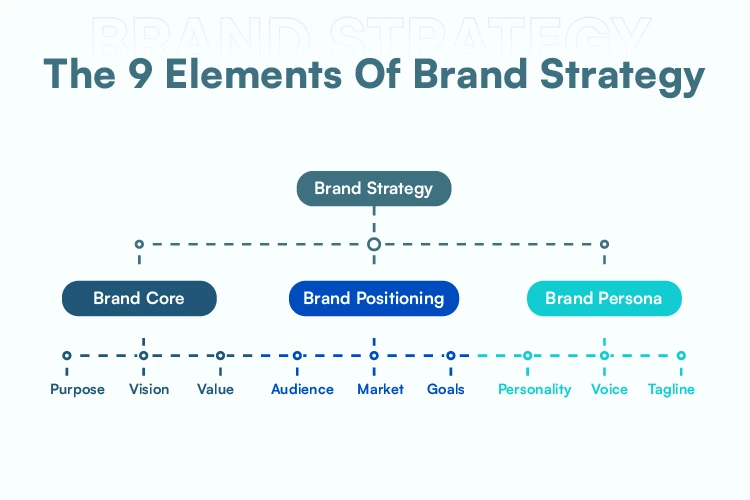Creating a strategy for your brand is challenging. A significant investment of time, resources, and research is required before launching a new brand or repositioning an existing one. You may map out the core of your business and your brand’s place in the market with a solid brand strategy.
Building your company’s name and prestige in the eyes of consumers is the goal of a brand strategy. The strategy will help your company stand out from the competition and achieve its intended demographic. However, the finest strategy will direct you toward the most crucial aspects of developing your company’s brand.
Let’s now learn how to create and manage a brand that people will love so much that they’ll select your company above the competition by following the advice in this blog. Let’s keep reading to learn the secrets of crafting the ideal brand and brand strategy.
The 3 Core Elements for Building Brand Strategy:
- Consistency: When your brand is consistent, it’s clear to people what they can expect from you. To keep the same, you need to show your loyal customers the same images and messages through all of your marketing outlets, such as your website, social media pages, ads, etc.
- Community: Once you have a clear picture of your brand, you can promote it or your business to the right people and build a community. You can look for customers who have the same ideals, behaviors, and personality traits as your business. So, a great brand is a measure of how your business is, both on the outside and on the inside.
- Content: At the end of the day, content is the way to reach the goals you have set for your brand. People always say that if you have good content, you can connect with your group. With good content, you’re always getting your potential customers interested and meeting their needs.
Now after having knowledge about the three core elements of building brand strategy comes another important point to be kept in mind is How to Define Your Brand.
- Vision statement: What do you want to accomplish, in a nutshell? What do you hold most dearly? How will this affect your brand’s image? A clear and compelling vision statement can help you and your team focus on the big picture and work together to achieve success.
- Value proposition: What unique benefit does your company offer to its clientele that no one else can match? Your company can stand out from the competition and provide the right service or product to the right customers if you and your team define your distinct value proposition.
- Positioning statement: A positioning statement articulates the desired market position. Branding is establishing a connection between a company’s desired image and the expectations of its target audience. The harmony described in your positioning statement is spot on.
Guide for Brand Strategy:
9 Elements of Brand Strategy:
The brand strategy framework comprises of 3 sections, namely brand core, brand positioning and brand persona with a total of 9 branding elements.

- Brand Purpose: Knowing and communicating the reason for your company’s existence can help you build loyalty among employees and customers. Consequently, it is essential to discover a meaning in your work. Therefore, identifying your brand’s purpose is the first and maybe most crucial step in creating a successful brand strategy.
- Brand Vision: Having a distinct goal in mind for your brand will serve as a guide for its future development. Because of this, your business decisions will be more in line with your growth objectives. You and your team need an audacious goal, one that will push you and inspire you, but it also needs to be achievable for people to believe in your plan to get there.
- Brand Values: Identifying your brand’s guiding principles is essential to developing a company culture and identity. You may use this to direct discussions and decisions, ensuring that your brand values are consistently upheld. Customers, partners, and the public will be able to see what you stand for by looking at your brand values.
- Target Audience: Knowing who you’re trying to reach is essential when establishing your brand’s niche. The most crucial part of the positioning aspect of your brand strategy is learning as much as possible about your target demographic. Their demographics, issues, difficulties, emotional leanings, and behavioral tendencies should all be considered.
- Market Analysis: Market research should involve looking for unfilled niches in order to identify your competitive advantage. Second, and as crucial, is conducting a market analysis to determine where your brand stands in relation to the competition. Every day, dozens of new brands enter the market, making competition fierce in practically every field. This is why it is essential to study the market and understand your competitors’ advantages and disadvantages.
- Awareness Goals: Plan out how you want people to find out about your business and give each method equal weight. Marketing efforts can be optimized by the establishment of priority among awareness objectives and campaigns. The goal of this component is to establish a strategy for spreading word about your brand to the people most likely to be interested in it. To ensure that your marketing budget is well spent, it is important to take into account the time and effort required for each potential marketing strategy.
- Business Personality: Give your business a personality by giving it a human side. This will help you build relationships with your most loyal customers. Setting up the personality of your brand will help you connect with your audience. It’s important to give your business a personality so that people can feel a real connection to it.
- Voice of Your Brand: You should always describe your tone of voice to tell your target audience how you want to sound. Once you know what your brand’s style is, the next step is to match it with the right tone of voice. Different brands will talk to their customers in different ways. So, it’s important to make sure you use it the same way in every way you talk to people.
- Brand Tagline: Put your message into a few short, easy-to-remember words that tell the story of your brand. By making a catchy tagline, you can tell the story of your brand in a few short words. It’s important to choose a tagline that says what your brand is about and shows where your brand stands.
Types of Brand Strategies:
Companies utilize a wide variety of tactics to raise awareness of their brands and sell their wares. Depending on your business’s target market, marketing budget, and other factors, the various varieties may be quite helpful.
However, with the right plan in place, you can establish a strong brand and identity and zero in on your long-term goals with laser-like precision. The quality of your brand can be improved with the help of the following tactics.

- Personal Branding: A person’s reputation, persona, or body of work can all be bolstered through the use of personal branding. Creating a name for yourself in the marketplace by conveying your unique selling proposition is the essence of personal branding. Intentionally harming one’s professional reputation through swaying public opinion is the goal.
- Corporate Branding: Corporate branding refers to a company’s overarching marketing philosophy. It’s an essential asset to any company. A company’s mission, personality, and basic values should permeate every touchpoint with its audience, from the initial point of contact through long after a customer has stopped doing business with the organization.
- Product Branding: Most branding efforts are focused on marketing a certain product. The strategy’s primary function is to help a product stand out from the competition. Symbols or visuals are important in product branding since they help consumers remember your goods. Advertising a specific product, a new product, or a top seller is also part of product branding.
- Service branding: Branding a service around the products and services your firm provides. What problems do your customers have that your solution solves? Only you can offer service branding that truly sets you apart from the competition by emphasizing the special experience you can give your customers. Customers’ wants and requirements are prioritized in this brand approach.
- Online branding: Internet branding, or online branding, is another important method of expanding a company’s name recognition. Helpful for businesses trying to make a name for themselves in cyberspace. Developing and marketing your brand’s social media presence is an integral part of this type of branding strategy. Branding techniques come in many forms, but this one is very useful for expanding your company’s name recognition and good name among consumers online.
- Co-Branding Strategy: One form of interfirm promotion is the co-branding approach. It’s a joint advertising effort by multiple businesses. This tactic encourages mutually beneficial interactions between brands, which can result in mutual growth, customer retention, and publicity boosts for both parties. Co-branding not only helps businesses attract new customers, but it also helps them save money and become more well-known in their respective markets.
- Retail Branding: In retail branding, an experience, a product, and a company’s reputation are all brought together. This plan of action can be easily adapted to a commercial retail setting. It joins a retail brand with an idea for a product.
- No Brand Branding: Branding with No Logo or no slogan. The idea behind “no-brand branding,” also known as “minimalist branding,” is that your items alone will be enough to attract customers. The packaging, colors, and overall style of the products are all quite basic. This approach also highlights low-priced, high-quality products, proving to customers that they need not overpay for name-brand items.
Steps to Create a Brand Strategy:
Step 1: Have a Clear Business Strategy
The first stage in developing a great brand is to establish clear and well-defined corporate goals and strategies.
In your business plan, you must explicitly describe the following factors.
- Your company’s purpose: Why does your company exist?
- Vision: What kind of future does your organization want to contribute to?
- Mission: How do you intend to build that future?
- Core values: What fundamental concepts influence your interactions with clients, workers, stakeholders, and society?
Step 2: Define Your Target Customers
Defining your target demographic is a critical step in developing a successful branding strategy. Without a clear definition of your target demographic, your branding initiatives will be a shot in the dark.
You will need the following information to construct a basic target audience:
- Information pertinent to your company
- Information based on demographics
- Information of interest
Step 3: Building a Brand Image
Brand image is the mental impression that your brand develops in the minds of potential customers who come into contact with your company.
If your target audience can readily comprehend your brand’s story, you will make a powerful impression on them. That is why it is critical to communicate clearly and precisely to the audience who visits your company’s website.
You may also project a brand image through existing customers by engaging with them in the manner in which you want them to perceive you.
Step 4: Building a Brand Identity
Having a distinct brand identity makes it easier for your target audience to distinguish you from the throng.
Here are some areas where you may add individuality and identity to your brand.
- Tagline and logo
- User involvement and experience
- Customer service and support initiatives
- The way you communicate on social media
- Your content’s overall communication tone
- Fonts, colors, and pictures are examples of aesthetic style.
Step 5: Building a Website
Your company’s website serves as a single point of contact for all of your potential consumers. It is most likely how your clients first learn about your company. As a result, a successful design talks to people and tells them where to search to discover what they want. The design should be such that it allows users to easily ingest the content.
Step 6: Build a Content Strategy
Good content can attract a lot of traffic to your company’s website and help it rank high in search engines.
- The tone of your content determines the identity of your brand.
- Being accurate aids in remaining relevant and on point.
- Strategically deploy call to actions
- Some ideal practices for content creation
MarTech Services for Building Brand Strategy:
Why is MarTech Important?
The use of technology in marketing has grown significantly in recent years. As MarTech services evolve, it helps companies stay up with their customers’ increasingly complex and fragmented experiences, and this is changing the marketing landscape once again. Therefore, technology is crucial for the development of contemporary advertising.
Marketing technology, or MarTech services, is also crucial since it helps us better interact with our clients. Developing stronger bonds with suppliers and distributors can have a positive ripple effect on your customer relationships.
How Is Martech Used in B2C, D2C and B2B Companies?
Both business-to-consumer (B2C) enterprises like McDonald’s, Walmart, and Amazon, and direct-to-consumer (D2C) businesses like Dollar Shave Club, Blue Apron, and Warby Parker prioritize its customers. Here, marketing is mostly transactional, with an emphasis on ensuring that customers view the firm favorably and develop an emotional connection to the brand.
On the contrary, businesses that cater to other businesses, including Salesforce, Slack, and Toast, are more about narrowing in on the right kind of clients, getting to know them on a deeper level, and being in constant contact with them. To achieve this goal, businesses use lead generation strategies to attract and convert potential customers using content marketing channels.
You need a solid brand strategy if you want your company and its products to succeed. Make sure you have a fantastic brand plan that caters to the wants of your dedicated clientele before you begin any branding efforts.
Always keep the best branding techniques in mind while expanding your brand’s audience or launching a new marketing campaign. Cuneiform’s brand planning services are always ready to assist you. We understand the challenges of competing brands in the same market and the value of including several brand strategies in your business plan. Therefore, Cuneiform’s marketing solutions will facilitate the development of different brand strategies and supply you with the most effective marketing approaches to make your brand stand out in the marketplace.




